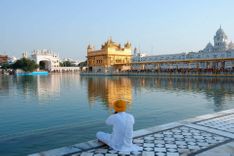#13 Kovalam Beach, Kovalam
Kovalam Beach, the third of the coves, is dominated from on high by the angular chalets of the five-star Leela Kempinski. Coachloads of excited Kerala day-trippers descend here on weekends, but at other times it offers a peaceful alternative to the beach further south, which is why it makes our list of the best beaches in India.
How to get to Kovalam Beach
This smaller beach is about a 10-minute walk (0.6 miles/1 km) from Lighthouse Beach along the coast. You can also get there directly by auto-rickshaw from Kovalam Junction. It’s located below the Leela Kempinski resort—public paths lead down to the sand, even though the hotel is nearby. Buses from Trivandrum stop close too, so it’s easy enough for a quick visit.
When to visit Kovalam Beach
Plan your visit between October and March when the weather is warm—around 80–88°F (27–31°C)—and mostly dry. Weekdays tend to be quieter than weekends, which are busier with local visitors. December and January usually have clear water and manageable waves for swimming. For the calmest vibe, try getting there before 10 am.
#14 Papa Nashini, Varkala
Known in Malayalam as Papa Nashini (“sin-destroyer”), Varkala’s beautiful white-sand beach has long been associated with ancestor worship. Devotees come here after praying at the ancient Janardhana Swamy Temple on the hill to the south, then perform mortuary rituals on the beach, directed by specialist pujaris (priests). The best time to watch the rites is in the early morning, just after sunrise — it's easily one of the best things to do in India.
How to get to Papa Nashini
You can reach this beach by auto-rickshaw from Varkala town (1.2 miles/2 km) or Varkala Sivagiri railway station (1.8 miles/3 km). The beach sits just below the Janardhana Swamy Temple on the southern cliff, with steps leading down from the temple grounds. If you're coming from Trivandrum (26 miles/42 km), buses run regularly to Varkala town, where you’ll need a short rickshaw ride to finish the trip.
When to visit Papa Nashini
Visit between October and March for comfortable weather, with temperatures usually ranging from 75–85°F (24–29°C). Early mornings are a good time to see traditional rituals carried out by priests near the water. The month of Karkidakam (July–August in the Malayalam calendar) is also an important time for religious ceremonies. If you’re looking for a more low-key experience, aim for a weekday morning.
#15 Papanasam Beach, Varkala
Backed by sheer red laterite cliffs, Varkala’s coastline is imposingly scenic and the beach relatively relaxing – although its religious associations do ensure that attitudes to public nudity (especially female) are less liberal than other coastal resorts in India.
Western sun-worshippers are supposed to keep to the northern end (away from the main puja area reserved for the funeral rites). There they are serviced by a nonstop parade of local “hallo-pineapple-coconut?” vendors. Sea otters can also occasionally be spotted playing on the cliffs by the sea.
How to get to Papanasam Beach
Auto-rickshaws run regularly from both Varkala town (1 mile/1.6 km) and Varkala Sivagiri railway station (1.8 miles/3 km). Once you’re at the cliff, a path connects the beach’s northern and southern ends, with stairs carved into the red cliffs leading down to the sand. The walk along the cliff is worth doing for the views alone.
When to visit Papanasam Beach
Between October and March, the beach is at its most pleasant, with temperatures around 80–86°F (27–30°C). The northern part tends to be quieter and is a popular spot for international visitors. During Onam (August–September), you might see traditional ceremonies taking place here. Early mornings and just before sunset are usually the best times to spot sea otters near the rocks.



















